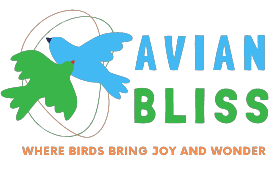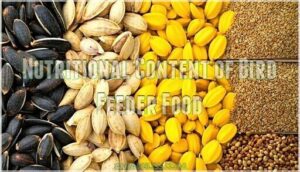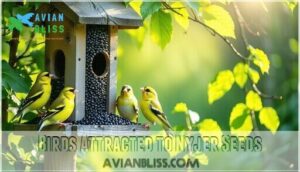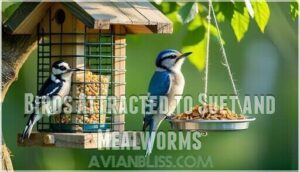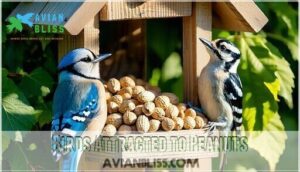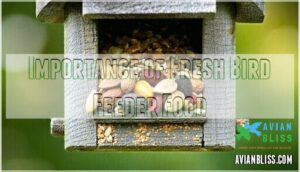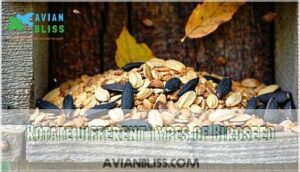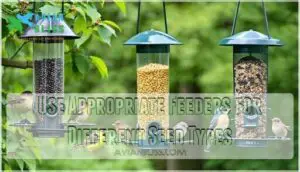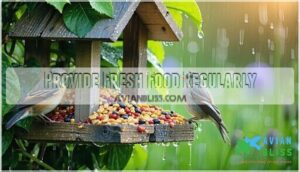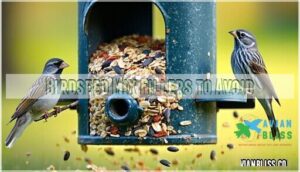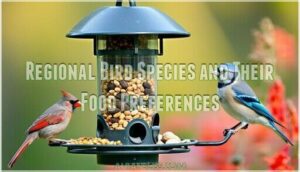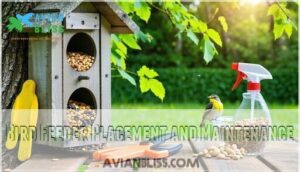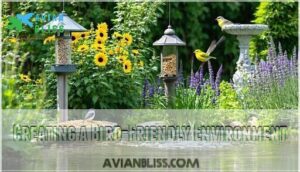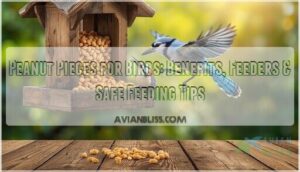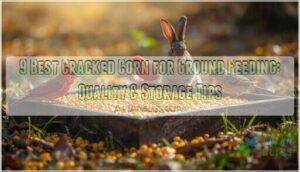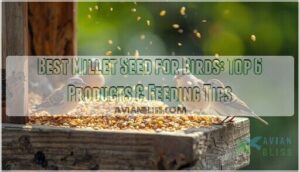This site is supported by our readers. We may earn a commission, at no cost to you, if you purchase through links.
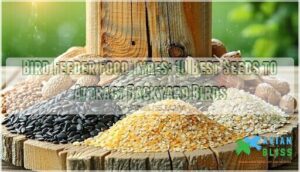
Nyjer seeds work like a magnet for finches, while safflower seeds keep squirrels at bay but welcome cardinals.
Suet provides essential fats for woodpeckers during colder months, and peanuts draw jays and woodpeckers year-round.
White millet appeals to ground-feeding birds like sparrows, though it’s often wasted in mixed blends.
Each seed type targets specific nutritional needs, with protein levels ranging from 15-20% and fat content varying from 25-50%, creating strategic combinations that support diverse bird populations throughout changing seasons.
Table Of Contents
- Key Takeaways
- Types of Bird Feeder Food
- Top 6 Bird Feeder Food Types
- Nutritional Content of Bird Feeder Food
- Bird Feeder Food and Attracted Bird Species
- Importance of Fresh Bird Feeder Food
- Tips for Successful Bird Feeding
- Birdseed Mix Fillers to Avoid
- Regional Bird Species and Their Food Preferences
- Bird Feeder Placement and Maintenance
- Creating a Bird-Friendly Environment
- Frequently Asked Questions (FAQs)
- What food should I put in my bird feeder?
- What is the 5 7 9 rule for bird feeders?
- What type of bird food is best?
- What can I fill my bird feeder with?
- What is the best food for bird feeders?
- Does type of bird food matter?
- What type of food gives birds the most energy?
- What type of feeder attracts the most birds?
- Can birds eat bread from my kitchen?
- How often should I clean bird feeders?
- Conclusion
Key Takeaways
- Choose black-oil sunflower seeds as your primary bird food since they attract the widest variety of species including cardinals, chickadees, and finches with their high fat content and thin shells that are easy to crack.
- Match specific seeds to target birds – use nyjer seeds for goldfinches, safflower seeds to deter squirrels while feeding cardinals, and suet cakes for woodpeckers during winter months when they need extra energy.
- Avoid cheap seed mixes containing fillers like milo, oats, and canary seed that most birds won’t eat, as these create waste and can attract unwanted pests while providing poor nutritional value.
- Keep your bird food fresh by storing seeds in cool, dry places and cleaning feeders every two weeks to prevent mold growth and bacterial contamination that can seriously harm or kill visiting birds.
Types of Bird Feeder Food
You’ll discover that different bird species prefer specific types of seeds, and choosing the right food can determine which feathered visitors appear at your feeders.
Understanding the nutritional content and attraction power of each seed type helps you create a backyard buffet that meets the dietary needs of cardinals, finches, woodpeckers, and dozens of other bird species.
Black-oil Sunflower Seeds
Among sunflower seeds, black oil sunflower seeds reign supreme for bird feeding.
Black oil sunflower seeds: the undisputed champion of backyard bird feeding that every feathered friend craves.
Their shell thinness makes cracking effortless for cardinals, chickadees, and finches, while nutritional benefits include high fat content essential for energy.
Bird preferences lean heavily toward this bird food type over traditional varieties.
Proper storage tips involve keeping bird seed in cool, dry locations.
Cost analysis shows excellent value for attracting diverse species with high fat content.
Striped Sunflower Seeds
While black oil sunflower seeds reign supreme, striped sunflower seeds offer unique advantages for your backyard feeding station.
These traditional sunflower seeds feature thicker shells and larger seed size, making them perfect for birds with powerful beaks like cardinals and blue jays.
The increased shell thickness naturally deters squirrels while providing excellent storage guidelines – they last longer than their black oil counterparts.
- Regional availability: Striped sunflower seeds cost less in many areas, making them budget-friendly bird food options.
Hulled Sunflower Seeds
Hulled sunflower seeds offer shell-free benefits that make feeding birds incredibly convenient.
You’ll love the easy access these seeds provide – no messy hulls cluttering your yard or feeders. Bird preferences lean heavily toward these premium seeds since finches, chickadees, and nuthatches can eat them effortlessly.
| Aspect | Details |
|---|---|
| Fat Content | 27-29% healthy fats |
| Protein | 14% essential protein |
| Storage | Cool, dry locations |
| Cost | Higher than regular sunflower seeds |
Proper seed storage prevents spoilage in your bird feeder.
Safflower Seeds
Safflower seeds offer a squirrel deterrent solution while maintaining strong cardinal attraction.
The seed hardness creates a natural barrier against unwanted visitors, yet cardinals, chickadees, and finches crack them easily.
These white-shelled seeds provide excellent nutritional benefits with high fat content for energy.
Use tube or hopper safflower feeders for best results.
This bird seed choice transforms your bird feeding experience by reducing competition and focusing on quality bird food selection.
Nyjer Seeds
Tiny nyjer seeds pack a nutritional punch that finches can’t resist. These oil-rich thistle seeds fit perfectly into small finch beaks, making them ideal finch food. Their high seed oil content provides essential energy for goldfinches and siskins.
Here’s what makes nyjer seeds special:
- Finch Beak Size – Small seeds match tiny finch beaks perfectly
- Nyjer Seed Storage – Keep cool and dry to maintain freshness
- Squirrel Deterrents – Less appealing to squirrels than other bird food
- Nyjer Feeder Types – Use mesh or tube feeders to prevent waste
- Seed Oil Content – High fat content attracts finches year-round
Peanuts
For backyard bird feeding, peanuts pack serious protein punch. You’ll attract jays, woodpeckers, and nuthatches with whole, shelled peanuts, or peanut pieces.
Skip salted varieties—birds need cleaned peanuts for peak health.
| Peanut Types | Bird Preferences |
|---|---|
| Whole in shell | Jays, crows |
| Shelled peanuts | Woodpeckers, chickadees |
| Peanut pieces | Nuthatches, titmice |
| Crushed hearts | Small songbirds |
Store in cool, dry conditions to prevent dangerous mold growth.
Mealworms
Protein-packed mealworms for birds deliver exceptional nutrition that bluebirds, robins, and wrens crave.
**Mealworms pack more protein punch per bite than any other backyard bird treat.
These wriggling treats provide essential fat and protein, especially during breeding season when birds need extra energy.
- Live vs Dried: Live mealworms offer maximum nutrition but require refrigeration, while dry mealworms provide convenience and longer storage.
- Mealworm Nutrition: High protein content supports healthy feather development and reproductive success.
- Feeding Frequency: Offer small portions in specialized mealworm feeders to complement regular seed feeding routines.
Suet
High-fat suet delivers essential calories when birds need them most.
You’ll find suet cakes made from raw fat combined with seeds, nuts, or mealworms at stores, or create DIY suet using rendering techniques.
Bird feeder suet attracts woodpeckers, nuthatches, and chickadees year-round.
Summer suet requires careful handling since heat causes melting and spoilage.
Suet ingredients vary, but quality matters for bird health.
Use specialized suet feeders with cages to prevent large birds from monopolizing food.
Store suet in cool, dry places to maintain freshness and prevent rancidity.
Suet Benefits Tips Birds Attracted
White Proso Millet
White proso millet serves as nature’s breakfast cereal for your feathered friends. This small, round seed delivers excellent millet nutrition through its carbohydrate-rich profile, making it perfect for ground feeders like sparrows, juncos, and doves.
You’ll find white millet works best when scattered directly on the ground or placed in low platform feeders.
Consider these key points about millet seeds:
- Regional availability varies, so check local suppliers for fresh bird seed
- Blends and millet combinations attract diverse species effectively
- Spoilage concerns require proper storage in dry conditions
- Ground feeders prefer this bird food over elevated options
Corn
While millet works well for smaller birds, cracked corn opens doors to larger ground-feeders like doves and quail.
This budget-friendly bird food packs energy-rich carbohydrates that fuel active birds.
Choose cracked corn over whole kernels since it’s easier for birds to digest.
Proper corn storage prevents dangerous mold growth – keep it dry and replace regularly for safe feeding.
Top 6 Bird Feeder Food Types
You’ll find that choosing the right bird feeder and food combination makes all the difference in attracting your target species to your backyard.
These six top-rated options provide reliable performance, from specialized thistle feeders that bring goldfinches to your yard to high-protein mealworms that attract bluebirds and wrens.
1. Gray Bunny Metal Bird Feeder
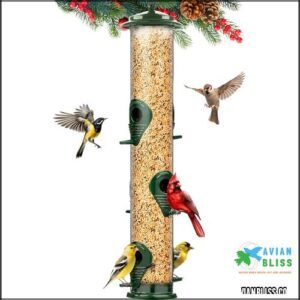
You’ve explored various bird food types, now let’s examine specific feeders that maximize your success.
The Gray Bunny Metal Bird Feeder stands out for feeder durability and weather resistance. Its metal construction withstands harsh conditions while six feeding ports accommodate multiple birds safely, ensuring bird safety.
The transparent design allows easy capacity analysis – you’ll know when refills are needed. Cleaning ease makes maintenance simple. Fill this bird feeder with black oil sunflower seeds or quality bird seed mixes for ideal bird feeding results among various bird feeder types.
Squirrel Baffle
Six feeding ports
2. Squirrel Proof Bird Feeder Large Capacity
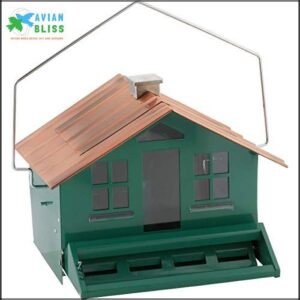
Beyond simple bird feeding, the Perky-Pet Squirrel-Be-Gone II transforms your backyard into a protected dining space.
This squirrel-proof design features weight-activated perches that slam shut when squirrels attempt access, ensuring your bird food stays where it belongs.
The impressive 8-pound capacity benefits both you and your feathered friends by reducing constant refills while providing ample seeds for busy feeding periods.
Squirrel deterrents that actually work:
- Watch frustrated squirrels slide off defeated while birds feast peacefully
- Feel the satisfaction of outsmarting persistent backyard bandits
- Enjoy uninterrupted bird watching without constant squirrel drama
Strategic feeder placement on poles or hanging positions maximizes effectiveness.
Simple maintenance tips include regular cleaning and checking moving parts.
This durable, rust-resistant bird feeder handles various squirrel-resistant seeds and mixed bird food perfectly.
3. Lyric Nyjer Seed Wild Bird Food
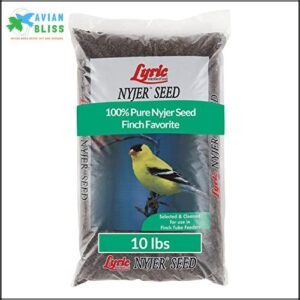
You’ll discover why serious bird watchers swear by Lyric Nyjer Seed Wild Bird Food when goldfinches start flocking to your yard.
These premium thistle seeds pack incredible nutritional value, delivering high-fat content that keeps finches energized through harsh winters.
Nyjer Seed Benefits include their sterilized processing, which prevents sprouting while maintaining peak freshness for months.
The tiny black seeds fit perfectly in specialized tube feeders, minimizing waste while maximizing Feeder Compatibility.
Lyric Seed Quality shines through their careful selection process, ensuring each batch meets strict standards for oil content and cleanliness.
For Seed Storage Tips, keep nyjer seeds in cool, dry places to preserve their nutritional oils.
This bird food investment pays off when you’re Attracting Finches like American Goldfinches and Pine Siskins consistently.
Feature Benefit Why It Matters
4. Kingsyard Thistle Bird Feeder for Wild Birds
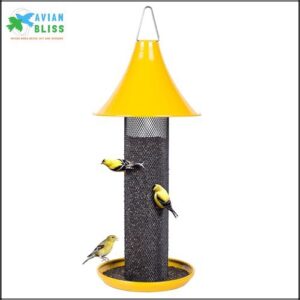
Looking beyond basic nyjer seeds, the Kingsyard Thistle Bird Feeder brings professional-grade quality to your backyard setup.
This 18-inch mesh design excels at attracting finches while minimizing seed waste reduction through its smart construction. The durable yellow coating withstands weather and squirrels, making it a reliable investment for serious bird watchers.
Key Benefits of Kingsyard Brand Quality:
- 360-degree access – Multiple perches let goldfinches and siskins feed comfortably from any angle
- Easy maintenance – Wide opening simplifies cleaning and refilling thistle seeds without mess
- Waste prevention – Fine mesh holds nyjer seeds securely, reducing ground scatter and costs
This thistle feeder design transforms ordinary bird feeding into an efficient, enjoyable experience.
5. Birds Choice Recycled Suet Cake Feeder
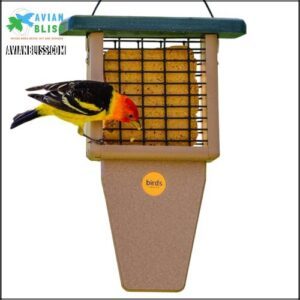
You’ll love the Birds Choice Recycled Suet Cake Feeder for its smart design and commitment to sustainability.
Built from recycled materials, this bird feeder offers exceptional weather resistance and feeder longevity that outperforms traditional plastic feeders.
The rust-resistant hinges and tail prop enhance bird accessibility, making it perfect for woodpeckers, nuthatches, and chickadees who need stable perching while feeding.
This feeder accommodates standard suet cakes effortlessly, and you can experiment with different suet variety options like hot pepper varieties to deter squirrels.
For bird feeder maintenance, simply wipe down the recycled poly lumber surface – it won’t crack, fade, or splinter like wood alternatives.
Following basic bird feeding tips and regular bird feeder cleaning keeps your backyard visitors healthy and happy.
6. Amzey Dried Mealworms High Protein Pet Food
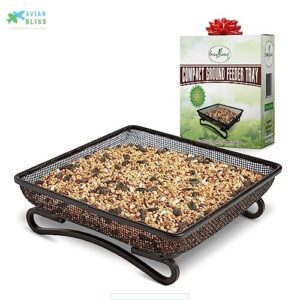
Among premium bird feeder food types, Amzey Dried Mealworms deliver exceptional mealworm nutrition for feeding wild birds. These protein-packed treats contain up to 50% protein content, making them ideal bird food for attracting bluebirds, chickadees, and wrens.
Mealworm benefits include supporting feather development, boosting immune systems, and providing essential energy during breeding season. Unlike live alternatives, dry mealworms offer mess-free convenience while maintaining nutritional value.
Sourcing mealworms from reputable suppliers guarantees quality and safety. Mealworm storage requires cool, dry conditions to prevent spoilage and maintain freshness for months.
You can serve them straight from the container or soak them briefly for softer texture. These high-energy treats work especially well during spring when parent birds need extra nutrition for raising young. Place them in specialized feeders or sprinkle on platform feeders for best results.
Nutritional Content of Bird Feeder Food
When you’re choosing bird feeder foods, understanding their nutritional content helps you select the best options for your backyard visitors.
Different seeds provide varying levels of fat, protein, and carbohydrates, with sunflower seeds offering 27-29% fat and 14% protein.
While suet delivers the highest calorie count at 850 calories per 3.5 ounces.
Fat Content in Bird Feeder Food
The fat content in bird feeder foods acts as nature’s rocket fuel for your feathered visitors.
Winter feeding becomes vital when birds need extra energy to survive harsh conditions. High-fat seeds like sunflower (62% fat), safflower (58% fat), and nyjer (69% fat) provide essential calorie sources that keep birds warm and energized.
- Sunflower seeds deliver concentrated energy through their impressive seed oiliness
- Suet’s caloric content reaches 850 calories per serving, perfect for energy needs
- Nyjer seeds contain the highest fat levels at 69% for ideal bird nutrition
- Winter months require high-fat foods to help birds maintain body temperature
These fat benefits guarantee your backyard birds thrive year-round.
Protein Content in Bird Feeder Food
Protein sources fuel your backyard birds’ energy needs, especially during breeding season when they’re raising young.
Peanuts deliver 27.9g of protein per 100g, nearly doubling sunflower seeds’ content. Mealworms pack the highest protein punch, making them perfect insect alternatives.
Suet protein combines fat with essential amino acids. These high-caloric content foods support muscle development and feather growth.
Mealworm benefits include attracting bluebirds and wrens. Peanut nutrition draws jays and woodpeckers reliably.
Carbohydrate Content in Bird Feeder Food
Carbohydrates fuel your backyard birds’ high-energy lifestyles, providing the quick energy they need for flight and foraging.
Understanding carb energy sources helps you choose the right seeds for ideal bird nutrition.
- Millet carbs deliver 73% carbohydrates, making white proso millet an excellent energy source
- Corn starch in cracked corn provides accessible carbohydrates for ground-feeding birds
- Sugar content varies across seed types, with simple carbs offering immediate energy
- Oat calories come primarily from complex carbohydrates that sustain longer activity
- Milo seeds contain moderate carbohydrates but attract fewer bird species
Bird Feeder Food and Attracted Bird Species
Understanding which birds eat specific seeds helps you attract the exact species you want in your backyard.
Different seed types act like specialized invitations, with cardinals preferring sunflower seeds while goldfinches flock to nyjer seeds.
Birds Attracted to Sunflower Seeds
Black oil sunflower seeds attract the widest variety of backyard birds, including Northern Cardinals, Chickadees, and House Finches.
These bird attractants offer excellent sunflower nutrition with thin shells that smaller birds crack easily.
Striped sunflower seeds appeal to larger species, while hulled sunflower seeds eliminate mess.
Your seed preferences and feeder types should match regional variations in local bird populations for maximum attraction.
Birds Attracted to Nyjer Seeds
While sunflower seeds draw diverse birds, nyjer seeds specifically target finches and smaller songbirds.
These tiny, oil-rich seeds attract goldfinches, Pine Siskins, and Common Redpolls with their high-fat content.
Nyjer benefits include:
- Finch preferences – Perfect size for small beaks
- Seed freshness – Stays viable longer than other seeds
- Feeder types – Works best in tube feeders with small ports
- Squirrel deterrence – Less appealing to larger pests
- Specialized attraction – Draws specific songbird species
Birds Attracted to Suet and Mealworms
While nyjer seeds work wonders for finches, suet and mealworms bring woodpeckers and bluebirds to your yard.
You’ll find suet’s high-caloric food content—around 850 calories per 3.5 ounces—makes it perfect for winter feeding when birds need extra energy.
Woodpeckers, nuthatches, and chickadees can’t resist this protein-packed treat.
Mealworms target insectivore bird diets beautifully.
Dried or live varieties attract bluebirds, wrens, and robins seeking protein boosts.
Use specialized mealworm feeder types like platform trays to prevent spillage.
Watch for suet spoilage risks in warm weather—replace it frequently to keep birds healthy.
Your bird feeder setup benefits from both options year-round, though suet shines during colder months.
High-fat energy
Peanut Suet
Dried Mealworms Protein Boost
Birds Attracted to Peanuts
Throughout your backyard feeding journey, peanuts serve as powerhouse snacks that draw impressive bird species.
Blue Jays, Woodpeckers, and Titmice can’t resist these high-fat treats in specialized Peanut Feeders.
Consider these essential factors for successful peanut feeding:
- Peanut Types: Choose unsalted, roasted varieties over salted options
- Shelling Peanuts: Offer both shelled peanuts and peanuts in the shell
- Peanut Allergies: Store properly to prevent harmful mold development
- Roasting Peanuts: Avoid raw peanuts that may contain toxins
Your bird feeder visitors will thank you!
Importance of Fresh Bird Feeder Food
You’ll want to keep your bird feeder food fresh because spoiled or moldy seeds can make birds sick and may even cause serious health problems.
Fresh food attracts more birds to your yard, while old or rancid seeds often get ignored by hungry visitors who can smell the difference.
Spoilage of Bird Feeder Food
Your bird feeder can become a health hazard when food spoils.
Mold growth thrives in damp conditions, creating dangerous toxins. Bacterial contamination spreads quickly through dirty feeders, while insect infestation attracts unwanted pests.
Weather effects accelerate rancidity, making seeds harmful to birds. Prevent food spoilage by storing seeds in airtight containers and maintaining proper bird feeder hygiene through regular cleaning.
Cause Risk Solution
Effects of Spoiled Bird Feeder Food on Birds
Spoiled food poses serious health risks to your backyard visitors. Mold toxicity and aflatoxin poisoning from food spoilage can trigger bacterial infections, respiratory problems, and death.
Reduced nutrition weakens birds’ immune systems, while toxins spread disease through contaminated feeders.
Here’s what happens when birds eat spoiled food:
- Their tiny bodies struggle against deadly aflatoxin poisoning
- Bacterial infections attack their vulnerable respiratory systems
- Weakened immunity leaves them defenseless against predators
- Disease spread kills entire flocks visiting your feeder
- Young chicks suffer most from contaminated food
Practice bird disease prevention through bird feeder mold prevention and bird feeder bacteria prevention.
Tips for Successful Bird Feeding
You’ll attract more birds when you rotate different seed types regularly and match feeders to specific seeds.
Keep your feeders clean and refill them with fresh food every few weeks to maintain bird health and encourage consistent visits, which will also help when you rotate different seed types to match feeders to specific seeds.
Rotate Different Types of Birdseed
You’ll keep your backyard visitors coming back by switching up your bird seed offerings throughout the year.
Seasonal rotation prevents birds from getting bored with the same old menu while attracting diversity to your feeders.
Try black oil sunflower seeds in spring, Nyjer during summer, and millet in fall.
This seed variety strategy caters to different bird preferences and reduces waste since you’re offering what birds actually want during each season.
Smart rotation of bird food varieties maximizes your success in attracting multiple species year-round.
Use Appropriate Feeders for Different Seed Types
Matching the right feeder to your bird seed types makes all the difference in attracting feathered friends.
Feeder size matters—small tube feeders work perfectly for nyjer seeds and finches, while larger hopper feeders accommodate sunflower seeds for cardinals.
Feeder material affects durability, with metal options lasting longer than plastic.
Consider seed flow—mesh feeders prevent waste with smaller seeds, while platform feeders suit mixed blends.
Bird size determines perch spacing and opening width.
Weather protection keeps seeds dry and prevents spoilage.
A great option is to buy a quality seed dispenser online.
The right bird feeder variety creates a backyard buffet that different species can’t resist visiting.
Provide Fresh Food Regularly
Once you’ve matched feeders to seeds, maintaining a consistent supply of fresh bird food becomes your next priority.
Monitor consumption patterns to determine refilling schedules.
Regular cleaning every two weeks will prevent spoilage and disease transmission.
Make seasonal adjustments by increasing portions during migration periods.
Replace any bird seed showing mold, moisture, or pest damage immediately for safe bird feeder operation.
Birdseed Mix Fillers to Avoid
Many birdseed mixes contain cheap filler ingredients that most birds won’t eat, leaving you with wasted food and empty feeders.
You’ll save money and attract more birds by avoiding mixes with milo, oats, and canary seed, which often end up scattered on the ground untouched.
Milo
You’ll find milo seeds in many cheap birdseed mixes, but they’re basically filler that most birds won’t touch.
This grain creates waste in your feeder and can attract unwanted pests when it sits uneaten.
Most backyard birds actively avoid milo, making it a poor choice for attracting diverse species to your yard.
- Low nutritional value compared to preferred seeds like sunflower or nyjer
- High spoilage risk when exposed to moisture, potentially harming birds
- Poor regional acceptance across North America’s common backyard species
Oats
While milo disappoints, oats present another challenge for bird enthusiasts.
You’ll find that oats attract California quail, brown-headed cowbirds, starlings, red-winged blackbirds, and doves, but most backyard birds ignore them completely.
| Oats vs. Better Alternatives | Appeal Rating |
|---|---|
| Uncooked Oats | Low (Limited Species) |
| Black Oil Sunflower Seeds | High (Most Birds) |
| White Proso Millet | High (Ground Feeders) |
| Nyjer Seeds | High (Finches) |
| Safflower Seeds | Medium (Cardinals) |
Oats spoilage occurs quickly when wet, creating waste and potential health risks for visiting birds.
Canary Seed
Canary seed sounds appealing, but most backyard birds ignore it completely.
This tiny seed offers few canary seed benefits for wild species and creates spoilage risks when left uneaten. Poor regional availability makes it expensive compared to proven alternatives.
Smart bird feeders skip canary seed for these winning options:
- Black oil sunflower seeds – Universal bird magnet
- Nyjer seeds – Goldfinch and siskin favorite
- White proso millet seeds – Ground-feeder essential
- Safflower seeds – Squirrel-proof choice
Regional Bird Species and Their Food Preferences
Your local bird species have specific food preferences that vary by geographic region, making it important to choose seeds that match the birds in your area.
For example, if you’re in eastern North America, you’ll attract different species with sunflower seeds and millet than someone in the western states would with the same food types, which highlights the need to understand local bird species.
Bird Species in Eastern North America
Over 200 bird species call Eastern North America home, creating a backyard birder’s paradise.
You’ll spot year-round residents like Northern Cardinals and Black-capped Chickadees alongside seasonal visitors such as Ruby-throated Hummingbirds and Baltimore Orioles.
Cardinal Diets favor sunflower seeds, while Finch Varieties prefer nyjer. Woodpecker Habits include suet consumption, and Sparrow Habitats range from urban areas to forest edges.
Jay Behavior shows intelligence when selecting bird seed from your bird feeders. Understanding these bird species helps you choose the right mixed bird seed to attract diverse visitors to your yard.
Notable Behavior
Loves sunflower seeds
Prefers insects
Highly active
Food Preferences of Birds in Eastern North America
Understanding regional variations in Eastern North America helps you choose the right bird seed for local species.
Your backyard becomes a dining hotspot when you match food to natural habitat impact and seasonal diet patterns.
Native foods work best for attracting regional bird species:
- White proso millet draws ground-feeding sparrows, doves, and juncos who prefer foraging near the ground
- Black-oil sunflower seeds satisfy finches, chickadees, and cardinals with their high-fat content and easy-to-crack shells
- Nyjer seeds attract introduced species like goldfinches while supporting their specialized feeding behaviors and nutritional needs
Bird Feeder Placement and Maintenance
You’ll need to place your bird feeders in locations that balance safety for birds with easy access for refilling and cleaning.
Regular maintenance, including weekly cleaning and checking for spoiled food, keeps your feeders safe and attractive to the birds you want to see in your yard.
Placement of Bird Feeders
Strategic bird feeder placement creates a perfect dining experience for your backyard visitors.
Position feeders near shrubs or trees for Weather Protection and Safety, giving birds quick escape routes from predators.
Maintain 10-12 feet of open space around feeders to prevent surprise attacks while ensuring Visibility for easy spotting.
Squirrel Deterrents work best when feeders are properly positioned.
Consider Accessibility for refilling and bird feeder positioning that complements your yard’s aesthetic appeal.
Cleaning and Maintenance of Bird Feeders
Once you’ve positioned your feeders perfectly, feeder hygiene becomes your next priority.
Clean monthly with hot soapy water followed by diluted bleach solution for mold prevention. Scrub away debris, rinse thoroughly, and air-dry completely.
For effective cleaning, consider using a dedicated cleaning product.
This routine cleaning stops material degradation while keeping squirrel deterrents functional.
Proper bird feeder maintenance tips guarantee healthy, disease-free dining spots year-round.
Creating a Bird-Friendly Environment
You’ll attract more birds to your yard when you create a complete habitat that goes beyond just filling feeders with seeds.
Adding fresh water sources like shallow birdbaths and planting native trees or shrubs gives birds the shelter, nesting spots, and natural food sources they need to visit your feeders regularly.
Providing Water Sources for Birds
Clean feeders are just the beginning—birds need fresh water daily to thrive.
Water source types include shallow dishes, birdbaths, and dripping fountains that attract different bird species.
Place your bird bath placement within ten feet of bird feeders for convenience.
Cleaning frequency should be weekly to prevent algae growth, while winter thawing requires heated elements.
Consider purchasing a bird bath to provide a dedicated water source.
Daily refills keep your feathered friends hydrated and healthy year-round.
Planting Bird-Friendly Trees and Shrubs
Beyond keeping feeders stocked, you’ll create a thriving bird habitat by adding native trees and berry bushes around your property.
These plants provide natural shelter options and nesting sites while producing fruits and berries that complement your bird feeder offerings.
Consider these top choices for attracting diverse bird species:
- Oak trees offer acorns and attract insect-eating birds year-round
- Elderberry bushes provide summer berries and seasonal blooms
- Dogwood trees supply fall fruits and dense branching for protection
Frequently Asked Questions (FAQs)
What food should I put in my bird feeder?
You’ll want black oil sunflower seeds as your go-to choice since they attract the widest variety of birds.
Add nyjer seeds for goldfinches and safflower seeds to deter squirrels while feeding cardinals.
What is the 5 7 9 rule for bird feeders?
You’ll place feeders 5 feet from shrubs, 7 feet from walkways, and 9 feet from your house. This spacing gives birds escape routes while keeping them visible for you to enjoy watching.
What type of bird food is best?
Black oil sunflower seeds reign supreme as the best bird food choice.
You’ll attract cardinals, chickadees, finches, and woodpeckers with these nutritious, high-fat seeds that provide excellent energy for year-round feeding.
What can I fill my bird feeder with?
Like a buffet spread for feathered friends, you can fill your feeder with black oil sunflower seeds, nyjer for finches, millet for ground feeders, or suet cakes for woodpeckers during winter months.
What is the best food for bird feeders?
Black oil sunflower seeds reign supreme as the best bird feeder food. They’re packed with calories, attract dozens of species, and have thin shells that most birds can crack easily.
Does type of bird food matter?
Different bird species have unique dietary preferences and beak shapes.
You’ll attract cardinals with sunflower seeds, goldfinches with nyjer, and woodpeckers with suet.
Matching food to your target birds makes all the difference.
What type of food gives birds the most energy?
Think of your feeder as a bird’s gas station – suet cakes pack the most energy punch at 850 calories per serving.
You’ll fuel hungry birds through winter’s harsh demands with this high-fat powerhouse.
What type of feeder attracts the most birds?
Tube feeders filled with black oil sunflower seeds attract the widest variety of birds. You’ll see cardinals, chickadees, finches, nuthatches, and woodpeckers all visiting. Multiple perches accommodate different species simultaneously.
Can birds eat bread from my kitchen?
Picture tossing leftover sandwich crusts into your backyard.
While birds can technically eat bread, it’s basically junk food for them.
Bread lacks essential nutrients and fills them up without providing proper nutrition they need.
How often should I clean bird feeders?
Clean your bird feeders every two weeks during regular use, or weekly during hot weather and heavy traffic. Use a bleach solution, rinse thoroughly, and let dry completely before refilling.
Conclusion
Successfully attracting diverse backyard birds requires understanding that different species have distinct dietary preferences rooted in their natural foraging behaviors.
By selecting appropriate bird feeder food types like black-oil sunflower seeds for cardinals, nyjer for finches, and suet for woodpeckers, you’ll create feeding stations that meet specific nutritional needs.
Fresh, high-quality seeds with proper fat and protein content guarantee healthy bird populations year-round.
Strategic food choices transform your backyard into a thriving wildlife habitat that benefits both birds and observers.
